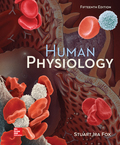
EBK HUMAN PHYSIOLOGY
15th Edition
ISBN: 9781260163049
Author: Fox
Publisher: MCGRAW HILL BOOK COMPANY
expand_more
expand_more
format_list_bulleted
Textbook Question
Chapter 20, Problem 2bCP
Describe the abnormalities characteristic of testicular feminization syndrome and of 5a-reductase deficiency and explain how these abnormalities are produced.
Expert Solution & Answer
Trending nowThis is a popular solution!

Students have asked these similar questions
Briefly state the physical meaning of the electrocapillary equation (Lippman equation).
Explain in a small summary how:
What genetic information can be obtained from a Punnet square? What genetic information cannot be determined from a Punnet square?
Why might a Punnet Square be beneficial to understanding genetics/inheritance?
In a small summary write down:
Chapter 20 Solutions
EBK HUMAN PHYSIOLOGY
Ch. 20 - Define the terms diploid and haploid, and explain...Ch. 20 - Explain how the chromosomal sex determines whether...Ch. 20 - List the male and female accessory sex organs and...Ch. 20 - Describe the abnormalities characteristic of...Ch. 20 - Prob. 3aCPCh. 20 - Prob. 3bCPCh. 20 - Prob. 4aCPCh. 20 - Prob. 4bCPCh. 20 - Prob. 4cCPCh. 20 - Prob. 5aCP
Ch. 20 - Prob. 5bCPCh. 20 - Prob. 6aCPCh. 20 - Prob. 6bCPCh. 20 - Describe the roles of FSH and testosterone in...Ch. 20 - Prob. 8aCPCh. 20 - Prob. 8bCPCh. 20 - Prob. 9aCPCh. 20 - Prob. 9bCPCh. 20 - Describe the changes that occur in the ovary and...Ch. 20 - Describe the formation, function, and fate of the...Ch. 20 - Prob. 11aCPCh. 20 - Explain the significance of negative feedback...Ch. 20 - Prob. 12aCPCh. 20 - Prob. 12bCPCh. 20 - List the fetal and maternal components of the...Ch. 20 - Prob. 13bCPCh. 20 - Prob. 14CPCh. 20 - Prob. 15CPCh. 20 - Prob. 1RACh. 20 - Prob. 2RACh. 20 - Prob. 3RACh. 20 - Prob. 4RACh. 20 - Prob. 5RACh. 20 - Prob. 6RACh. 20 - Prob. 7RACh. 20 - Prob. 8RACh. 20 - Which of these statements is true?
Ch. 20 - Prob. 10RACh. 20 - Prob. 11RACh. 20 - Prob. 12RACh. 20 - Prob. 13RACh. 20 - Prob. 14RACh. 20 - Prob. 15RACh. 20 - The contents of the birth control pill
Ch. 20 - Which of the following statements regarding...Ch. 20 - Prob. 18RACh. 20 - Prob. 19RACh. 20 - Prob. 20RACh. 20 - Prob. 21RACh. 20 - Prob. 22RACh. 20 - Prob. 23RACh. 20 - Prob. 24RACh. 20 - Prob. 25RACh. 20 - Prob. 26RACh. 20 - Prob. 27RACh. 20 - Describe the steps of oogenesis when fertilization...Ch. 20 - Prob. 29RACh. 20 - Prob. 30RACh. 20 - Prob. 31RACh. 20 - Prob. 32RACh. 20 - Prob. 33RACh. 20 - Prob. 34RACh. 20 - Prob. 35RACh. 20 - Prob. 36RACh. 20 - Prob. 37RACh. 20 - Prob. 38RACh. 20 - Prob. 39RACh. 20 - Prob. 40RACh. 20 - Prob. 41RACh. 20 - Prob. 42RACh. 20 - Prob. 43RACh. 20 - Prob. 44RA
Knowledge Booster
Learn more about
Need a deep-dive on the concept behind this application? Look no further. Learn more about this topic, biology and related others by exploring similar questions and additional content below.Similar questions
- Not part of a graded assignment, from a past midtermarrow_forwardNoggin mutation: The mouse, one of the phenotypic consequences of Noggin mutationis mispatterning of the spinal cord, in the posterior region of the mouse embryo, suchthat in the hindlimb region the more ventral fates are lost, and the dorsal Pax3 domain isexpanded. (this experiment is not in the lectures).a. Hypothesis for why: What would be your hypothesis for why the ventral fatesare lost and dorsal fates expanded? Include in your answer the words notochord,BMP, SHH and either (or both of) surface ectoderm or lateral plate mesodermarrow_forwardNot part of a graded assignment, from a past midtermarrow_forward
- Explain in a flowcharts organazing the words down below: genetics Chromosomes Inheritance DNA & Genes Mutations Proteinsarrow_forwardplease helparrow_forwardWhat does the heavy dark line along collecting duct tell us about water reabsorption in this individual at this time? What does the heavy dark line along collecting duct tell us about ADH secretion in this individual at this time?arrow_forward
arrow_back_ios
SEE MORE QUESTIONS
arrow_forward_ios
Recommended textbooks for you
 Nutrition Through The Life CycleHealth & NutritionISBN:9781337919333Author:Brown, Judith E.Publisher:Cengage Learning,
Nutrition Through The Life CycleHealth & NutritionISBN:9781337919333Author:Brown, Judith E.Publisher:Cengage Learning, Human Physiology: From Cells to Systems (MindTap ...BiologyISBN:9781285866932Author:Lauralee SherwoodPublisher:Cengage Learning
Human Physiology: From Cells to Systems (MindTap ...BiologyISBN:9781285866932Author:Lauralee SherwoodPublisher:Cengage Learning- Essentials of Pharmacology for Health ProfessionsNursingISBN:9781305441620Author:WOODROWPublisher:Cengage

Nutrition Through The Life Cycle
Health & Nutrition
ISBN:9781337919333
Author:Brown, Judith E.
Publisher:Cengage Learning,

Human Physiology: From Cells to Systems (MindTap ...
Biology
ISBN:9781285866932
Author:Lauralee Sherwood
Publisher:Cengage Learning


Essentials of Pharmacology for Health Professions
Nursing
ISBN:9781305441620
Author:WOODROW
Publisher:Cengage


The Human Reproductive System; Author: Professor Dave Explains;https://www.youtube.com/watch?v=TucxiIB76bo;License: Standard YouTube License, CC-BY